Feature-First Add-On for Trajectory Simplification in Lifelog Applications
Abstract
1. Introduction
2. GPS Trajectory Data
- GPS status: The data set quality (V = invalid, A = valid)
- GPS quality indicator: The GPS fix type (0 = no GPS, 1 = GPS SPS, 2 = DGPS, 3 = GPS PPS). It indicates whether the GPS receiver has fixed onto satellites’ data and received enough data to determine the location.
- Horizontal dilution of precision (HDOP): DOP tells the effect of satellite geometry on measurement accuracy. The precision of the calculated position is reduced when GPS’ four reference satellites are close together. HDOP describes the influence of satellite geometry on the position upon a 2D plane. The positional error is proportional to the value of HDOP.
- Altitude, mean sea-level (geoid): The geoid is a theoretical surface, which is defined by the gravity, of the Earth. It is often used as a reference level for measuring height.
- Geoidal separation: The difference between the WGS-84 earth ellipsoid surface and the geoid in meter. An ellipsoid is an approximation of the true shape of the Earth for convenient manipulations.
3. The Feature-First Trajectory Simplification
- LOST point (L): The location where a GPS receiver has problematic satellite signals for a period longer than a predefined time TfixL.
- FOUND point (F): The location, followed by a LOST point, where a GPS receiver has valid satellite signals for a period longer than a predefined time TfixF.
- STALL point (S): The location where the object stops moving and remains stationary within a predefined distance DmaxS for a period longer than a predefined time TmovS.
- GO point (G): The location, followed by a STALL point, where the object moves faster than a predefined speed SminG for a period longer than a predefined time TmovG.
- TURN point (T): The location where the object turns larger than a predefined angle ΘminT.
- eXTRA tune point (X): The location, between any consecutive feature points within a trajectory, where applications demand for recording with optional requirements. Certain parameters Xn may be considered depending on the requirements.
3.1. Douglas–Peucker (DP) Algorithm
3.2. Uniform Sampling (US) Algorithm
4. A Case Study
4.1. Context of Trajectory by FFTS
4.2. Performance of FFTS
5. Conclusions
Funding
Conflicts of Interest
Appendix A
| Day#1 | Day#2 | Day#3 | Day#4 | Day#5 | Day#6 | Day#7 | Average | Stdev | ||
|---|---|---|---|---|---|---|---|---|---|---|
| DP | DDP = 200 | 25.7 | 30.5 | 26.7 | 31.7 | 31.8 | 29.6 | 41.9 | 31.1 | 5.3 |
| DDP = 100 | 22.1 | 21.7 | 22.3 | 17.1 | 20.8 | 19.9 | 21.0 | 20.7 | 1.8 | |
| DDP = 50 | 9.3 | 10.9 | 8.8 | 10.4 | 8.1 | 8.9 | 8.4 | 9.2 | 1.1 | |
| DDP = 30 | 6.2 | 5.3 | 6.0 | 5.0 | 3.7 | 5.2 | 5.6 | 5.3 | 0.8 | |
| DDP = 20 | 4.5 | 3.5 | 3.7 | 3.6 | 3.0 | 3.5 | 4.3 | 3.7 | 0.5 | |
| US | DDP = 200 | 45.3 | 55.2 | 62.0 | 51.6 | 80.6 | 49.4 | 99.1 | 63.3 | 19.6 |
| DDP = 100 | 45.9 | 48.2 | 49.2 | 72.3 | 57.4 | 37.6 | 94.1 | 57.8 | 19.3 | |
| DDP = 50 | 26.2 | 28.8 | 24.5 | 24.7 | 27.9 | 23.2 | 22.7 | 25.4 | 2.3 | |
| DDP = 30 | 18.6 | 16.5 | 19.0 | 14.8 | 27.0 | 14.8 | 22.2 | 19.0 | 4.4 | |
| DDP = 20 | 16.5 | 13.2 | 14.0 | 11.8 | 16.4 | 11.3 | 18.7 | 14.6 | 2.7 | |
| FFDP | DDP = 200 | 31.4 | 22.7 | 25.6 | 24.1 | 25.3 | 24.0 | 21.3 | 24.9 | 3.2 |
| DDP = 100 | 10.4 | 13.7 | 10.6 | 11.2 | 12.0 | 13.6 | 11.7 | 11.9 | 1.3 | |
| DDP = 50 | 7.7 | 7.1 | 7.1 | 6.5 | 5.9 | 9.1 | 7.8 | 7.3 | 1.0 | |
| DDP = 30 | 4.0 | 4.4 | 4.9 | 4.4 | 3.6 | 4.7 | 3.8 | 4.2 | 0.5 | |
| DDP = 20 | 2.9 | 3.5 | 3.4 | 3.1 | 2.5 | 3.4 | 3.2 | 3.1 | 0.3 | |
| FFUS | DDP = 200 | 30.8 | 25.0 | 25.8 | 36.0 | 41.8 | 32.4 | 40.3 | 33.2 | 6.6 |
| DDP = 100 | 22.5 | 23.7 | 27.1 | 29.1 | 28.2 | 21.2 | 19.4 | 24.5 | 3.7 | |
| DDP = 50 | 15.7 | 15.7 | 12.1 | 13.7 | 17.1 | 13.4 | 13.1 | 14.4 | 1.8 | |
| DDP = 30 | 11.2 | 11.6 | 9.9 | 9.5 | 11.5 | 10.4 | 11.9 | 10.9 | 0.9 | |
| DDP = 20 | 7.1 | 6.8 | 8.6 | 10.5 | 9.1 | 7.3 | 9.8 | 8.4 | 1.4 |
| Day#1 | Day#2 | Day#3 | Day#4 | Day#5 | Day#6 | Day#7 | Average | Stdev | ||
|---|---|---|---|---|---|---|---|---|---|---|
| DP | DDP = 200 | 177.9 | 136.0 | 173.1 | 171.9 | 129.1 | 149.8 | 256.9 | 170.7 | 42.6 |
| DDP = 100 | 174.2 | 124.6 | 168.5 | 168.5 | 110.0 | 118.2 | 203.8 | 152.5 | 35.0 | |
| DDP = 50 | 88.9 | 71.1 | 93.3 | 102.5 | 87.9 | 74.6 | 137.0 | 93.6 | 21.9 | |
| DDP = 30 | 81.4 | 36.6 | 85.5 | 63.8 | 85.9 | 48.3 | 86.3 | 69.7 | 20.5 | |
| DDP = 20 | 61.8 | 32.8 | 67.5 | 61.8 | 85.0 | 39.7 | 64.1 | 59.0 | 17.6 | |
| US | DDP = 200 | 131.0 | 119.8 | 128.9 | 126.1 | 154.5 | 125.7 | 211.7 | 142.5 | 32.4 |
| DDP = 100 | 104.5 | 88.5 | 122.8 | 115.0 | 99.8 | 104.2 | 156.0 | 113.0 | 21.9 | |
| DDP = 50 | 59.1 | 67.3 | 63.9 | 53.8 | 54.7 | 53.2 | 56.3 | 58.3 | 5.4 | |
| DDP = 30 | 42.6 | 37.9 | 41.9 | 31.6 | 43.6 | 28.8 | 47.5 | 39.1 | 6.7 | |
| DDP = 20 | 33.2 | 26.3 | 34.9 | 25.0 | 32.2 | 22.2 | 39.6 | 30.5 | 6.2 | |
| FFDP | DDP = 200 | 133.4 | 102.4 | 91.6 | 87.7 | 107.4 | 80.2 | 120.2 | 103.3 | 18.8 |
| DDP = 100 | 115.8 | 92.8 | 70.8 | 72.0 | 96.0 | 69.4 | 104.5 | 88.8 | 18.4 | |
| DDP = 50 | 106.9 | 45.5 | 58.9 | 56.7 | 88.2 | 61.6 | 80.1 | 71.1 | 21.4 | |
| DDP = 30 | 98.4 | 38.0 | 54.3 | 51.7 | 85.4 | 28.8 | 74.6 | 61.6 | 25.4 | |
| DDP = 20 | 92.6 | 36.2 | 36.4 | 34.3 | 83.0 | 24.0 | 52.1 | 51.2 | 26.4 | |
| FFUS | DDP = 200 | 76.2 | 74.0 | 77.4 | 75.9 | 81.3 | 81.5 | 100.8 | 81.0 | 9.2 |
| DDP = 100 | 58.4 | 64.9 | 67.2 | 55.0 | 58.1 | 55.8 | 57.1 | 59.5 | 4.7 | |
| DDP = 50 | 40.1 | 46.9 | 37.3 | 34.3 | 37.6 | 28.1 | 40.0 | 37.7 | 5.8 | |
| DDP = 30 | 31.3 | 27.1 | 29.5 | 20.5 | 23.3 | 23.2 | 33.9 | 27.0 | 4.9 | |
| DDP = 20 | 20.0 | 18.6 | 22.2 | 21.0 | 18.9 | 15.2 | 26.5 | 20.3 | 3.5 |
| Day#1 | Day#2 | Day#3 | Day#4 | Day#5 | Day#6 | Day#7 | Average | Stdev | ||
|---|---|---|---|---|---|---|---|---|---|---|
| DP | DDP = 200 | 99.30 | 99.39 | 99.39 | 99.33 | 99.22 | 99.57 | 99.52 | 99.39 | 0.12 |
| DDP = 100 | 99.18 | 99.29 | 99.29 | 99.19 | 98.93 | 99.44 | 99.22 | 99.22 | 0.15 | |
| DDP = 50 | 98.69 | 98.98 | 98.86 | 98.73 | 98.43 | 99.11 | 98.85 | 98.81 | 0.22 | |
| DDP = 30 | 98.37 | 98.45 | 98.54 | 98.09 | 97.90 | 98.77 | 98.57 | 98.38 | 0.30 | |
| DDP = 20 | 97.99 | 97.94 | 98.17 | 97.77 | 97.54 | 98.44 | 98.32 | 98.03 | 0.31 | |
| US | DDP = 200 | 99.27 | 99.34 | 99.34 | 99.28 | 99.14 | 99.52 | 99.47 | 99.34 | 0.13 |
| DDP = 100 | 99.13 | 99.24 | 99.24 | 99.13 | 98.86 | 99.39 | 99.17 | 99.17 | 0.16 | |
| DDP = 50 | 98.63 | 98.93 | 98.81 | 98.67 | 98.36 | 99.07 | 98.80 | 98.75 | 0.23 | |
| DDP = 30 | 98.31 | 98.40 | 98.49 | 98.03 | 97.79 | 98.72 | 98.53 | 98.32 | 0.32 | |
| DDP = 20 | 97.93 | 97.86 | 98.12 | 97.68 | 97.47 | 98.40 | 98.28 | 97.96 | 0.33 | |
| FFDP | DDP = 200 | 98.63 | 98.85 | 98.78 | 98.70 | 98.25 | 99.03 | 98.74 | 98.71 | 0.24 |
| DDP = 100 | 98.57 | 98.78 | 98.68 | 98.58 | 98.15 | 98.92 | 98.69 | 98.62 | 0.24 | |
| DDP = 50 | 98.40 | 98.45 | 98.47 | 98.23 | 97.83 | 98.75 | 98.48 | 98.37 | 0.28 | |
| DDP = 30 | 98.02 | 98.01 | 98.22 | 97.88 | 97.43 | 98.38 | 98.09 | 98.01 | 0.30 | |
| D_DP = 20 | 97.76 | 97.86 | 97.69 | 97.42 | 97.11 | 98.14 | 97.77 | 97.68 | 0.33 | |
| FFUS | DDP = 200 | 98.51 | 98.78 | 98.73 | 98.61 | 98.25 | 98.98 | 98.78 | 98.66 | 0.23 |
| DDP = 100 | 98.43 | 98.70 | 98.61 | 98.49 | 97.90 | 98.92 | 98.53 | 98.51 | 0.32 | |
| DDP = 50 | 98.05 | 98.42 | 98.32 | 98.17 | 97.68 | 98.62 | 98.25 | 98.22 | 0.30 | |
| DDP = 30 | 97.79 | 97.94 | 98.03 | 97.54 | 97.08 | 98.36 | 98.09 | 97.83 | 0.42 | |
| DDP = 20 | 97.50 | 97.48 | 97.76 | 97.19 | 96.90 | 98.08 | 97.86 | 97.54 | 0.40 |
References
- Gurrin, C.; Smeaton, A.F.; Doherty, A.R. LifeLogging: Personal Big Data. Found. Trends Inf. Retr. 2014, 8, 1–125. [Google Scholar] [CrossRef]
- Karkar, R.; Fogarty, J.; Kientz, J.A.; Munson, S.A.; Vilardaga, R.; Zia, J. Opportunities and challenges for self-experimentation in self-tracking. In Proceedings of the ACM Symposium on Wearable Computers, Osaka, Japan, 9–11 September 2015. [Google Scholar]
- Huang, H.; Gartner, G.; Krisp, J.M.; Raubal, M.; Van de Weghe, N. Location based services: Ongoing evolution and research agenda. J. Locat. Based Serv. 2018, 12, 63–93. [Google Scholar] [CrossRef]
- Tanaka, G.; Okada, M.; Mineno, H. GPS-Based Daily Context Recognition for Lifelog Generation Using Smartphone. Int. J. Adv. Comput. Sci. Appl. 2015, 6, 104–112. [Google Scholar] [CrossRef][Green Version]
- Fillekes, M.P.; Kim, E.-K.; Trumpf, R.; Zijlstra, W.; Giannouli, E.; Weibel, R. Assessing Older Adults’ Daily Mobility: A Comparison of GPS-Derived and Self-Reported Mobility Indicators. Sensors 2019, 19, 4551. [Google Scholar] [CrossRef] [PubMed]
- Zou, Z.; Yu, Z.; Cao, K. An Innovative GPS Trajectory Data Based Model for Geographic Recommendation Service. Trans. GIS 2017, 21, 880–896. [Google Scholar] [CrossRef]
- Zhang, D.; Ding, M.; Yang, D.; Liu, Y.; Fan, J.; Shen, H.T. Trajectory simplification: An experimental study and quality analysis. Proc. VLDB Endow. 2018, 11, 934–946. [Google Scholar] [CrossRef]
- Qian, H.; Lu, Y. Simplifying GPS Trajectory Data with Enhanced Spatial-Temporal Constraints. Int. J. Geo-Inf. 2017, 6, 329. [Google Scholar] [CrossRef]
- Muckell, J.; Olsen, P.W., Jr.; Hwang, J.-H.; Lawson, C.T.; Ravi, S.S. Compression of trajectory data: A comprehensive evaluation and new approach. GeoInformatica 2014, 18, 435–460. [Google Scholar] [CrossRef]
- Muckell, J.; Hwang, J.-H.; Lawson, C.T.; Ravi, S.S. Algorithms for compressing GPS trajectory data: An empirical evaluation. In Proceedings of the SIGSPATIAL International Conference on Advances in Geographic Information Systems, San Jose, CA, USA, 2–5 November 2010. [Google Scholar]
- Meratnia, N.; de By, R.A. Spatiotemporal compression techniques for moving point objects. In Lecture Notes in Computer Science, Proceedings of the International Conference on Extending Database Technology, Heraklion, Greece, 14–18 March 2004; Springer: Berlin/Heidelberg, Germany, 2014; pp. 765–782. [Google Scholar]
- Douglas, D.H.; Peucker, T.K. Algorithms for the reduction of the number of points required to represent a digitized line or its caricature. Int. J. Geogr. Inf. Geovis. 1973, 10, 112–122. [Google Scholar] [CrossRef]
- Cao, W.; Li, Y. DOTS: An online and near-optimal trajectory simplification algorithm. J. Syst. Softw. 2017, 126, 34–44. [Google Scholar] [CrossRef]
- Muckell, J.; Hwang, J.-H.; Patil, V.; Lawson, C.T.; Ping, F.; Ravi, S. SQUISH: An online approach for GPS trajectory compression. In Proceedings of the International Conference on Computing for Geospatial Research & Applications, Washington, DC, USA, 23–25 May 2011. [Google Scholar]
- The Global Positioning System (GPS). Available online: https://www.gps.gov/ (accessed on 26 June 2019).
- Tsui, J.B.-Y. Fundamentals of Global Positioning System Receivers, 2nd ed.; John Wiley & Sons, Inc.: Hoboken, NJ, USA, 2005. [Google Scholar]
- Stefan, J. Navigating with GPS. Circuit Cellar 2000, 123, 22–27. [Google Scholar]
- National Marine Electronics Association (NMEA). Available online: https://www.nmea.org/ (accessed on 24 December 2018).
- Zhu, N.; Marais, J.; Betaille, D.; Berbineau, M. GNSS position integrity in urban environments: A review of literature. IEEE Trans. Intell. Transp. Syst. 2018, 19, 2762–2778. [Google Scholar] [CrossRef]
- An, J.-W.; Kim, Y.-K.; Lee, J.-K.; Lee, J. Precision Positioning of a Stationary Transporter Using a Fault Detection and Isolation Method. J. Inst. Control Robot. Syst. 2016, 22, 859–868. [Google Scholar] [CrossRef]
- FGPMMOPA6H GPS Standalone Module Data Sheet; Revision V0A; GlobalTop Technology Inc.: Tainan, Taiwan, 2012; Available online: www.gtop-tech.com (accessed on 19 October 2018).
- Suryakumar, B.; Ramadevi, E. An Improved Multi-Context Trajectory Embedding Model using Parameter Tuning Optimization for Human Trajectory Data Analysis. Int. J. Appl. Eng. Res. 2018, 13, 15633–15637. [Google Scholar]
- Yang, X.; Stewart, K.; Tang, L.; Xie, Z.; Li, Q. A Review of GPS Trajectories Classification Based on Transportation Mode. Sensors 2018, 18, 3741. [Google Scholar] [CrossRef] [PubMed]
- Zhenga, Y. Trajectory data mining: An overview. ACM Trans. Intell. Syst. Technol. 2015, 6, 1–41. [Google Scholar] [CrossRef]

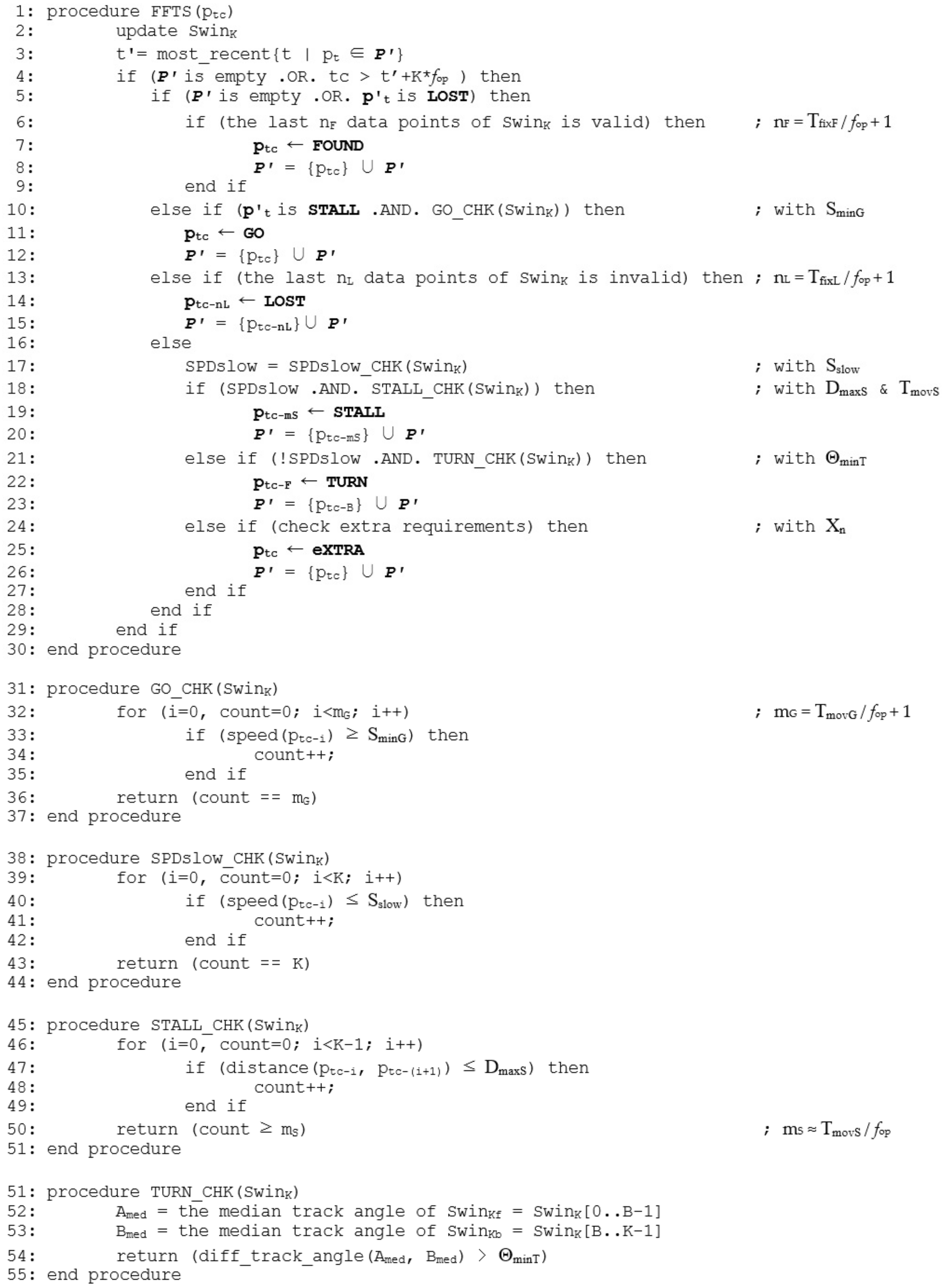
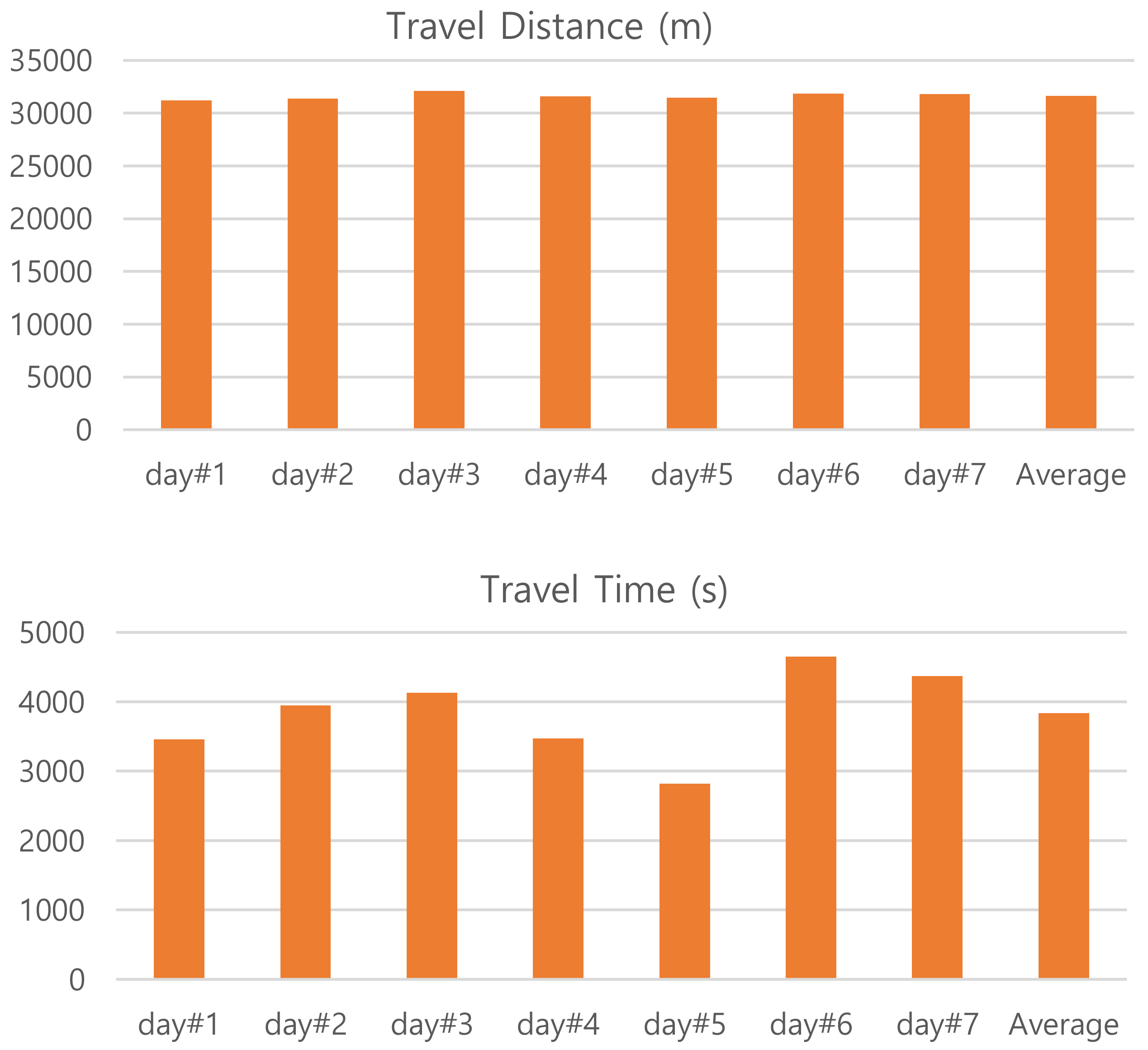
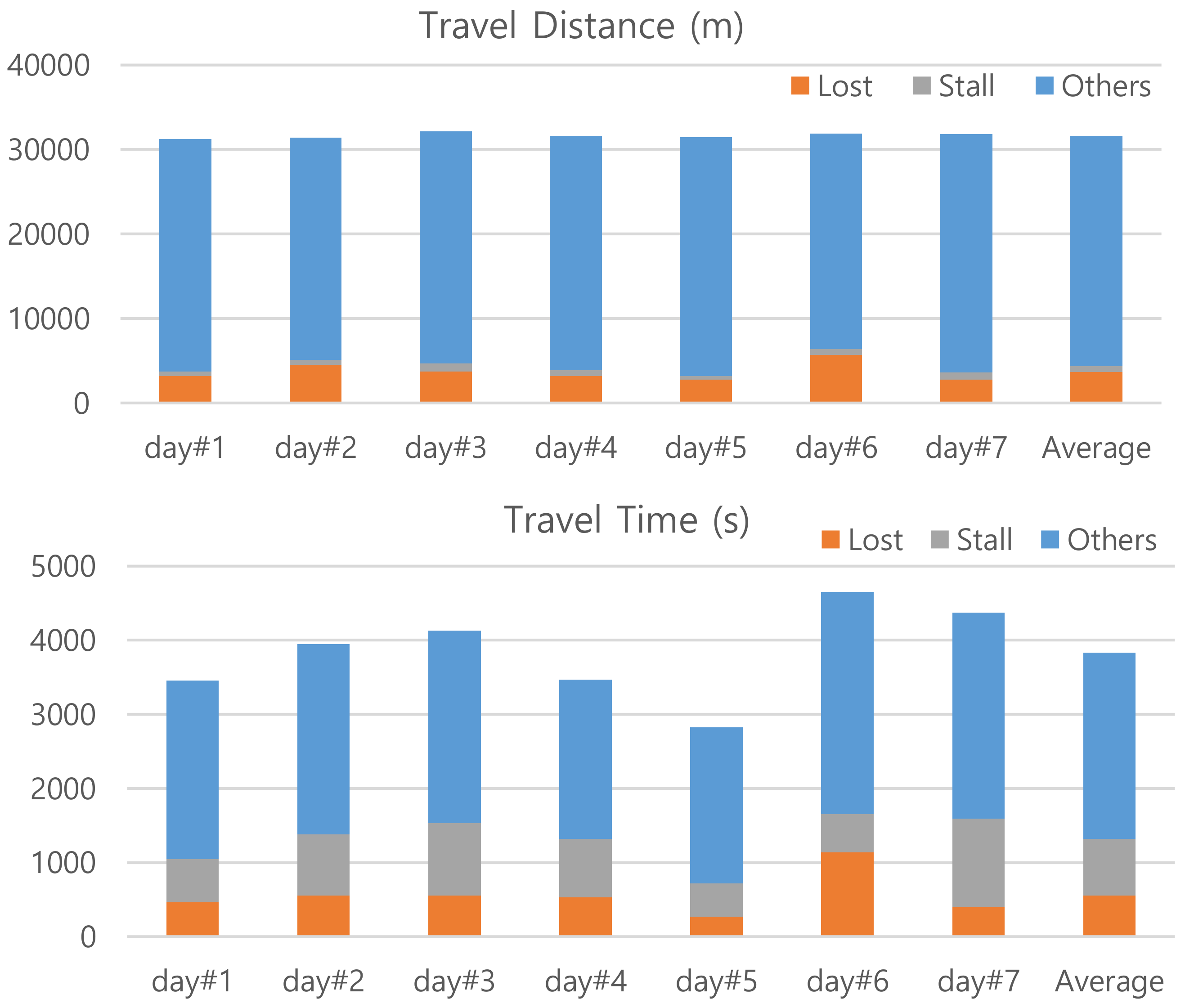
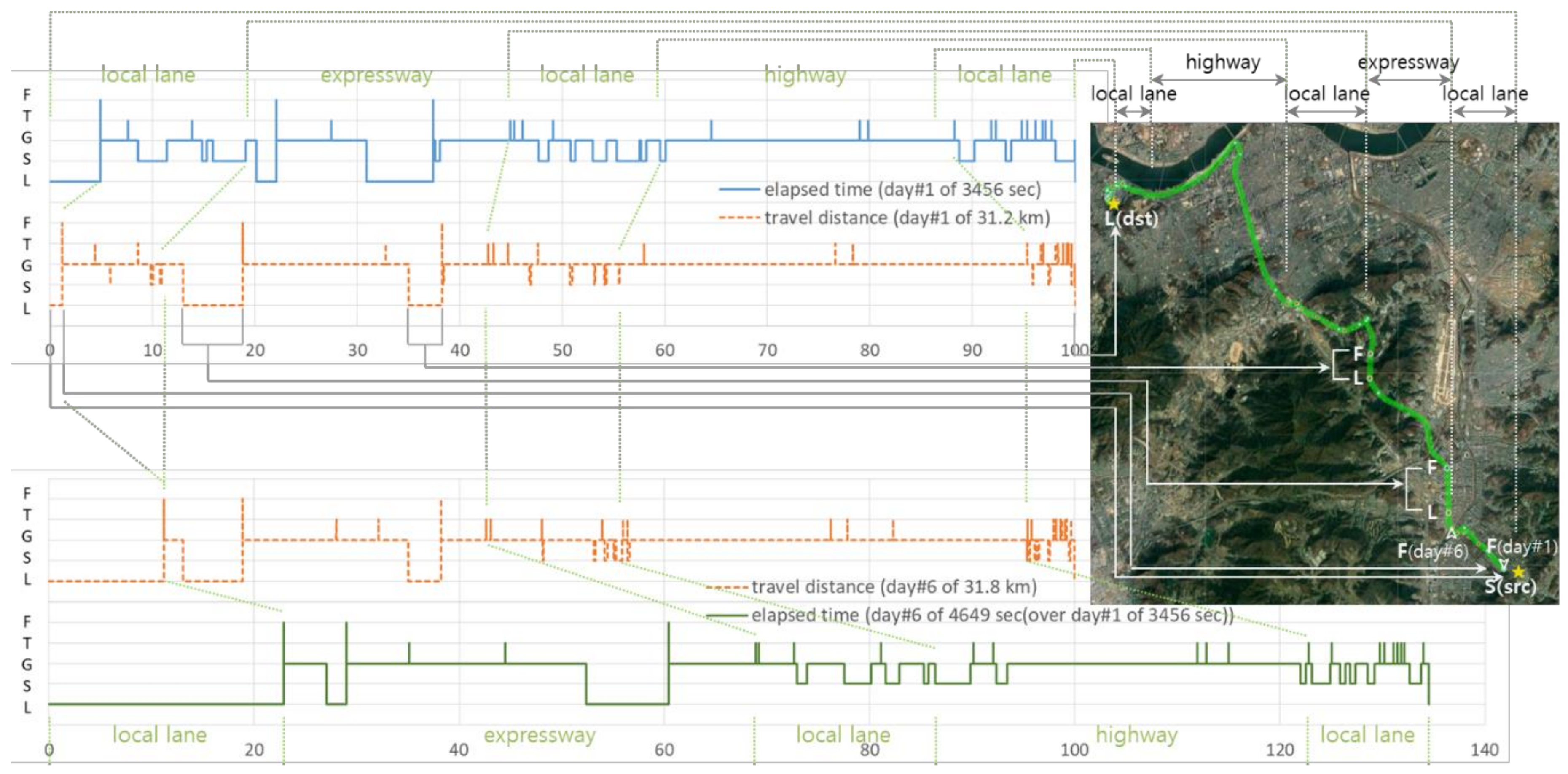
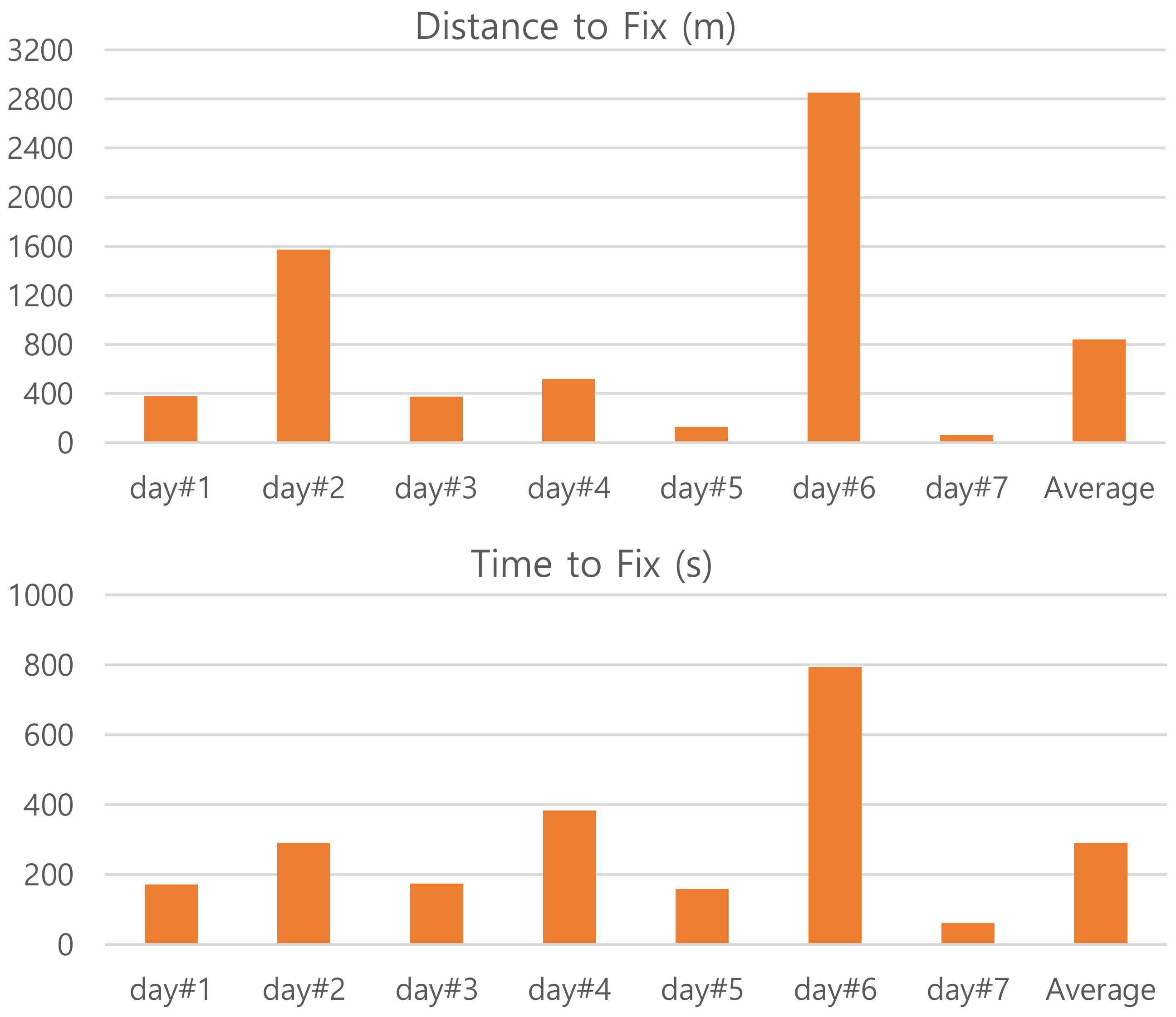
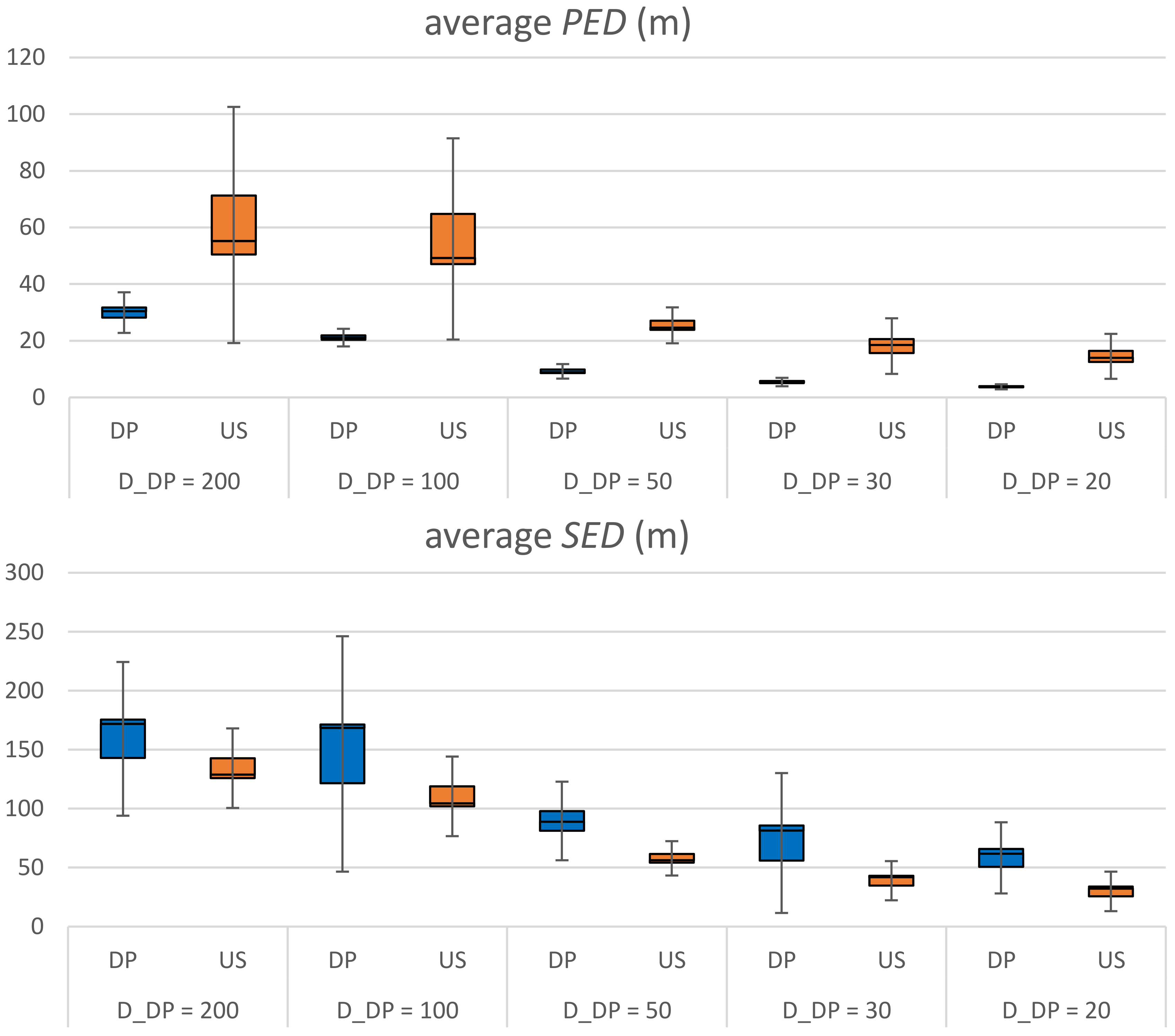

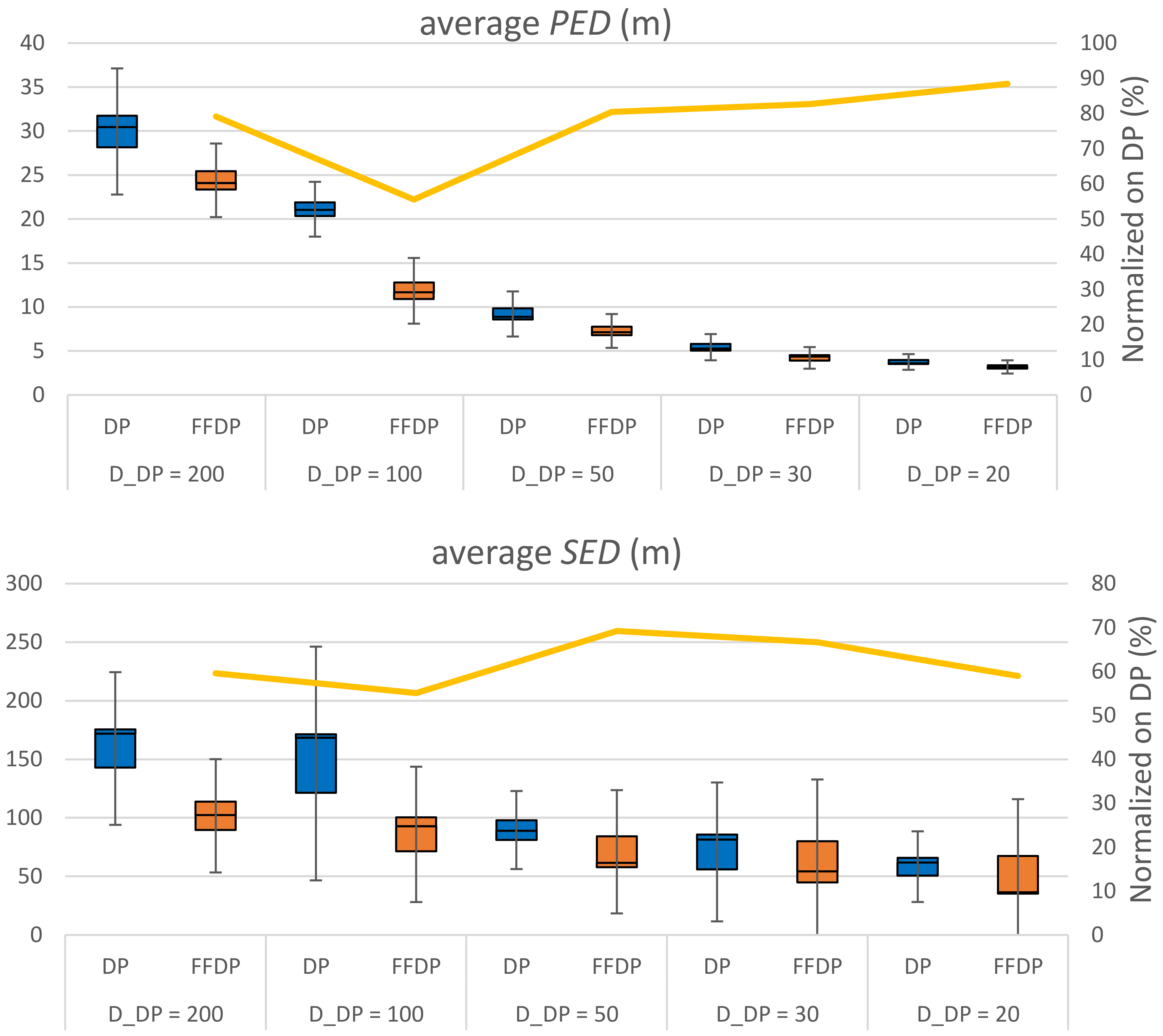
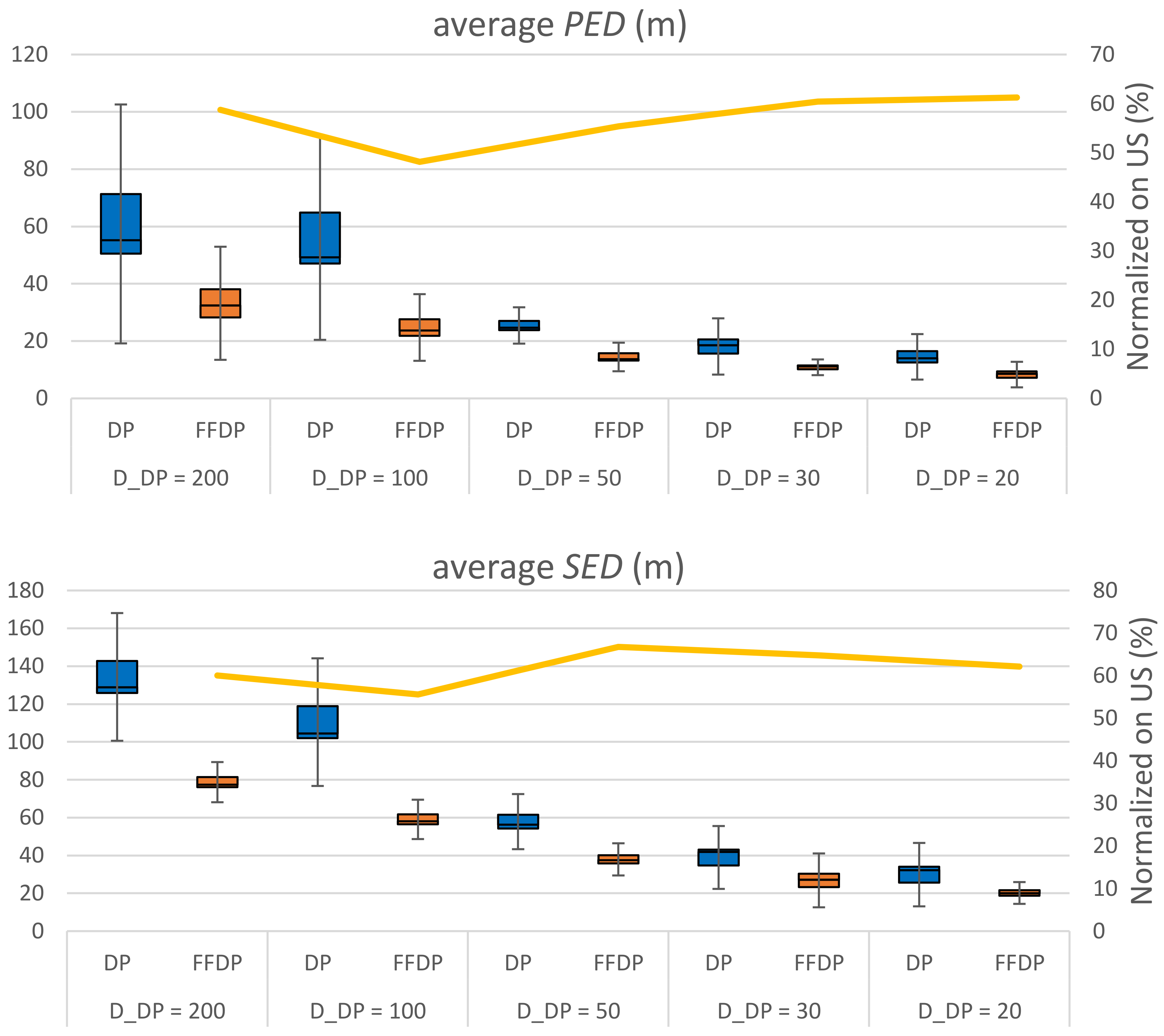
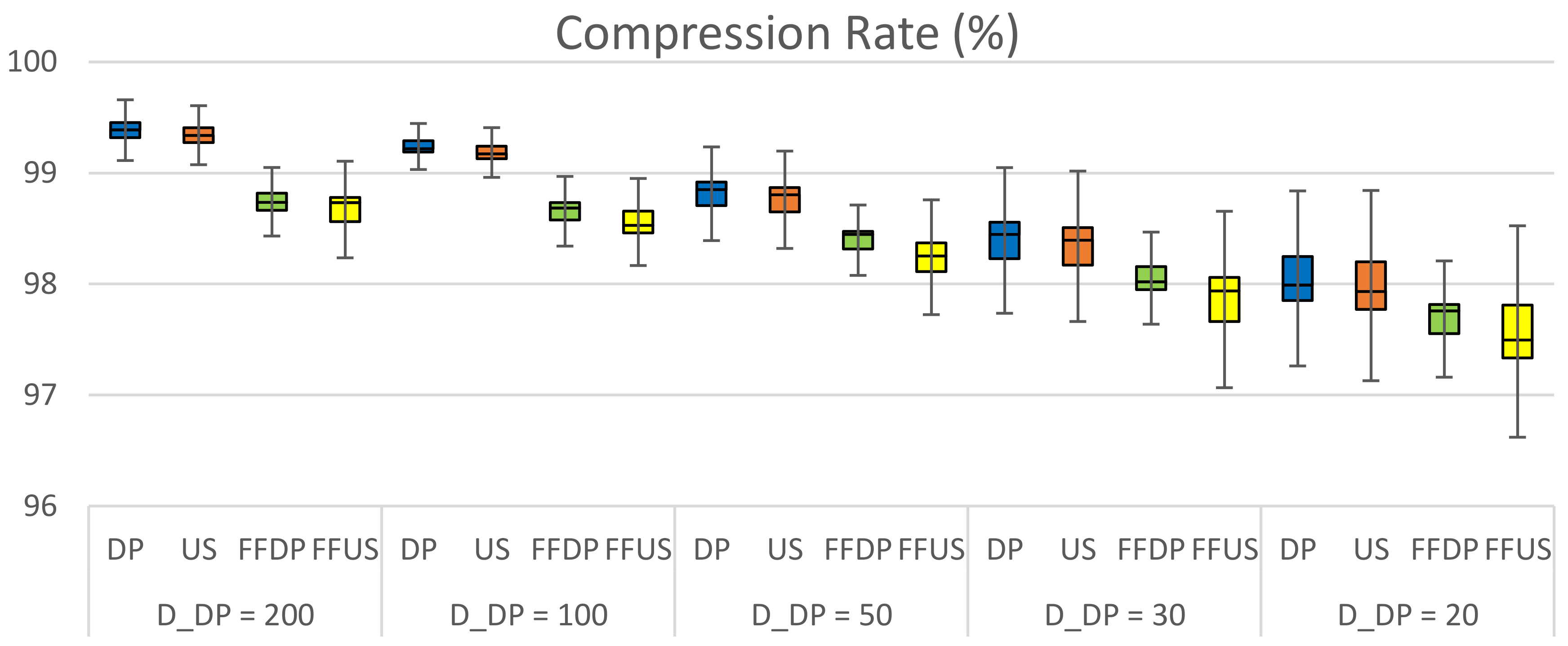
© 2020 by the author. Licensee MDPI, Basel, Switzerland. This article is an open access article distributed under the terms and conditions of the Creative Commons Attribution (CC BY) license (http://creativecommons.org/licenses/by/4.0/).
Share and Cite
Kim, J. Feature-First Add-On for Trajectory Simplification in Lifelog Applications. Sensors 2020, 20, 1852. https://doi.org/10.3390/s20071852
Kim J. Feature-First Add-On for Trajectory Simplification in Lifelog Applications. Sensors. 2020; 20(7):1852. https://doi.org/10.3390/s20071852
Chicago/Turabian StyleKim, JunSeong. 2020. "Feature-First Add-On for Trajectory Simplification in Lifelog Applications" Sensors 20, no. 7: 1852. https://doi.org/10.3390/s20071852
APA StyleKim, J. (2020). Feature-First Add-On for Trajectory Simplification in Lifelog Applications. Sensors, 20(7), 1852. https://doi.org/10.3390/s20071852





